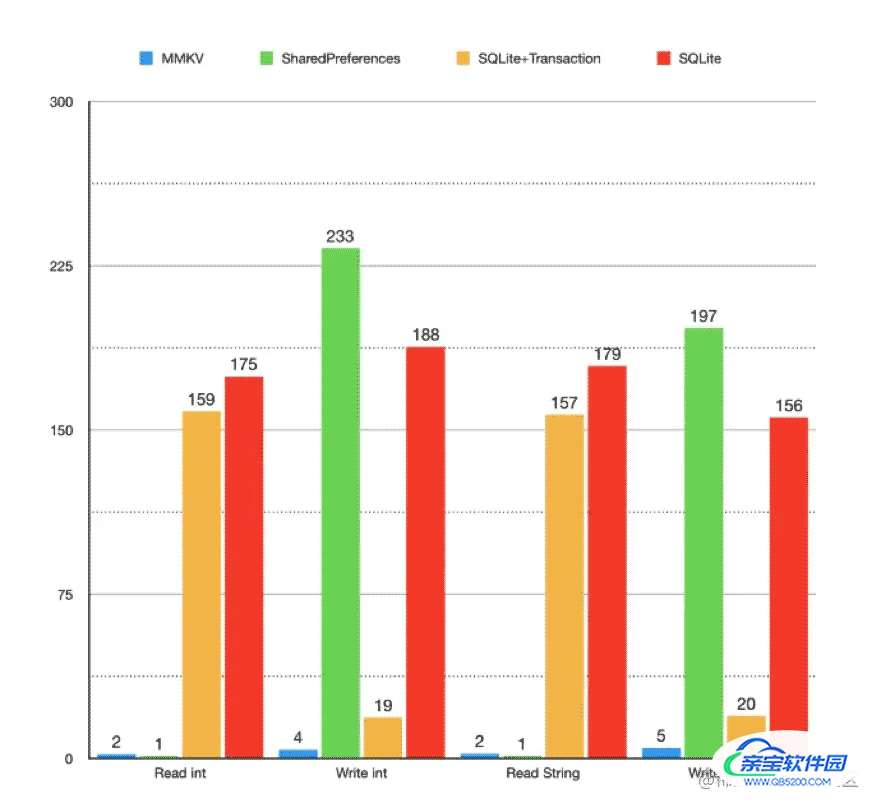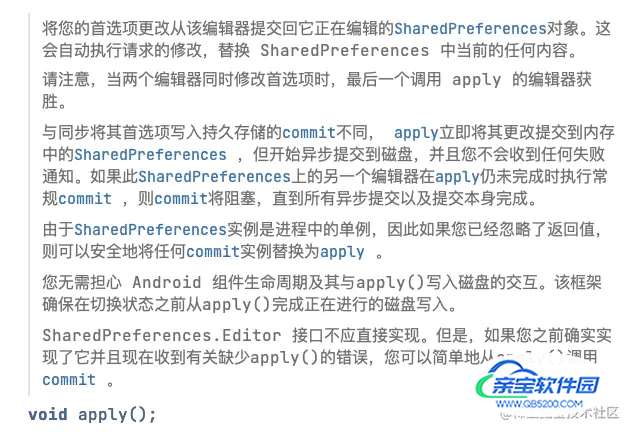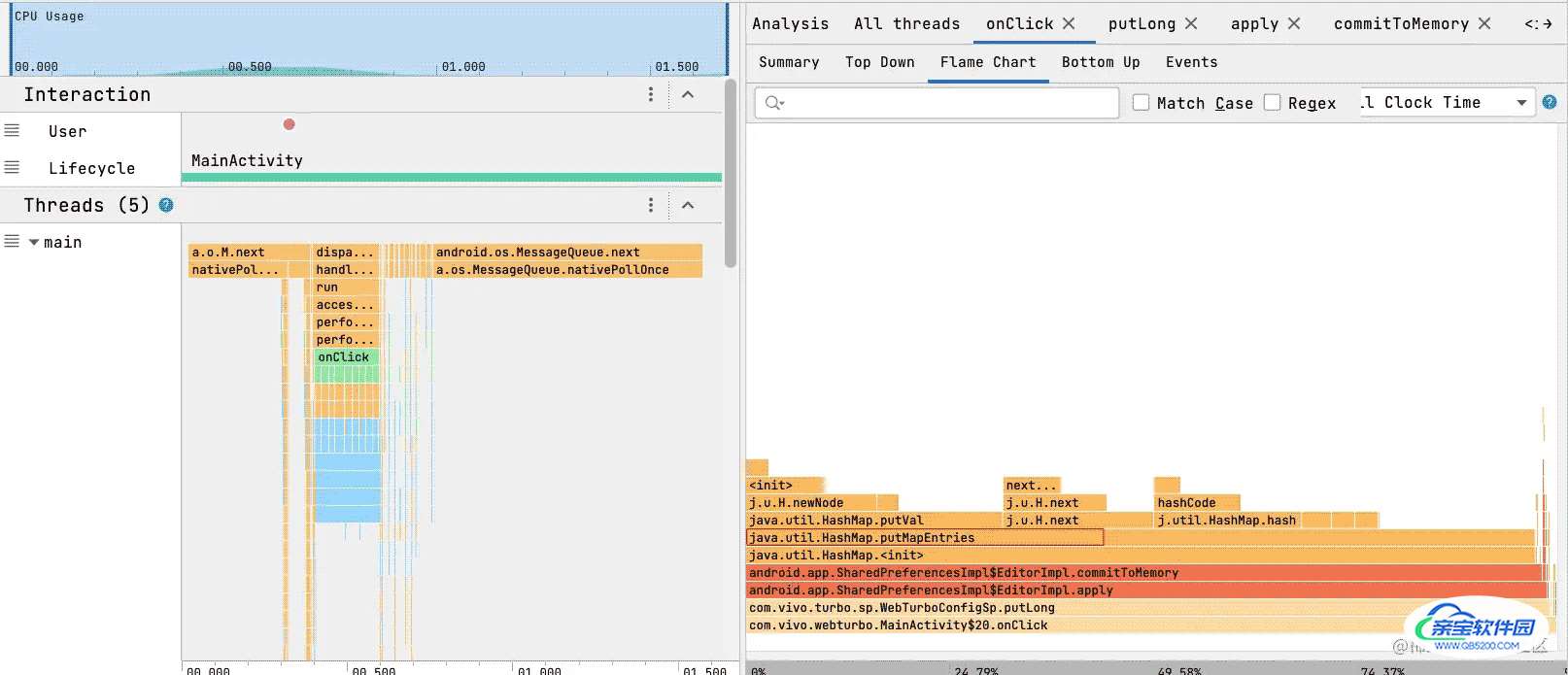Android SharedPreferences性能瓶颈解析
冰河本尊 人气:0正文
想必大家对SharedPreferences都已经很熟悉了,大型应用使用SharedPreferences开发很容易出现性能瓶颈,相信很多开发者已经迁移到MMKV进行配置存储
说到MMKV我们总是会看到如下这张图

在模拟1000次写入的情况下,MMKV大幅度领先SharedPreferences,我们都知道MMKV使用了mmap方式进行存储,而SharedPreferences还是使用传统的文件系统,以xml的方式进行配置存储,mmap确实具备较好的性能和稳定性,但是真的两种不同的存储方式可以带来如此巨大的性能差异吗?
测试
因此我编写代码进行了一次测试
findViewById(R.id.test5).setOnClickListener(new View.OnClickListener() {
@Override
public void onClick(View v) {
long time2 = System.currentTimeMillis();
SharedPreferences mSharedPreferences = WebTurboConfiguration.getInstance().mContext.getSharedPreferences(WebTurboConfigSp.Key.SHARED_PREFS_FILE_NAME, Context.MODE_PRIVATE);
SharedPreferences.Editor editor = mSharedPreferences.edit();
for (int i = 0; i < 1000; i++) {
editor.putString(i + "", 1000 + "");
editor.apply();
}
long time3 = System.currentTimeMillis();
Log.e("模拟写入", "sp存储耗时 = " + (time3 - time2));
MMKV mmkv = MMKV.defaultMMKV();
for (int i = 0; i < 1000; i++) {
mmkv.putString(i + "", 1000 + "");
}
long time4 = System.currentTimeMillis();
Log.e("模拟写入", "mmkv 存储耗时 = " + (time4 - time3));
}
});
输出如下
E/模拟写入: sp存储耗时 = 82ms
E/模拟写入: mmkv 存储耗时 = 6ms
MMKV确实性能显著强于SharedPreferences
apply方法的注释
SharedPreferences在使用的时候是推荐使用apply进行保存,我们来看一下apply方法的注释

注释中明确说明apply方法是先将存储数据提交到内存,然后异步进行磁盘写入,既然是异步写入,理论上IO不会拖后腿,我们可以认为时间都被消耗在了将数据提交到内存上,在写入内存上面SharedPreferences与MMKV会有这么大的性能差距吗?
这激起了我的兴趣
我使用AS自带的性能分析工具对SharedPreferences存储过程进行一次trace分析 分析图如下

可以轻松的从图中看到
数据存储put方法的主要耗时在puMapEntries上
代码调用如下
SharedPreferences的实际实现代码在SharedPreferencesImpl中
@Override
public void apply() {
final long startTime = System.currentTimeMillis();
final MemoryCommitResult mcr = commitToMemory();
final Runnable awaitCommit = new Runnable() {
@Override
public void run() {
try {
mcr.writtenToDiskLatch.await();
} catch (InterruptedException ignored) {
}
if (DEBUG && mcr.wasWritten) {
Log.d(TAG, mFile.getName() + ":" + mcr.memoryStateGeneration
+ " applied after " + (System.currentTimeMillis() - startTime)
+ " ms");
}
}
};
QueuedWork.addFinisher(awaitCommit);
Runnable postWriteRunnable = new Runnable() {
@Override
public void run() {
awaitCommit.run();
QueuedWork.removeFinisher(awaitCommit);
}
};
SharedPreferencesImpl.this.enqueueDiskWrite(mcr, postWriteRunnable);
notifyListeners(mcr);
}
主要看
final MemoryCommitResult mcr = commitToMemory();
代码比较长
private MemoryCommitResult commitToMemory() {
long memoryStateGeneration;
boolean keysCleared = false;
List<String> keysModified = null;
Set<OnSharedPreferenceChangeListener> listeners = null;
Map<String, Object> mapToWriteToDisk;
synchronized (SharedPreferencesImpl.this.mLock) {
if (mDiskWritesInFlight > 0) {
mMap = new HashMap<String, Object>(mMap);
}
mapToWriteToDisk = mMap;
mDiskWritesInFlight++;
boolean hasListeners = mListeners.size() > 0;
if (hasListeners) {
keysModified = new ArrayList<String>();
listeners = new HashSet<OnSharedPreferenceChangeListener>(mListeners.keySet());
}
synchronized (mEditorLock) {
boolean changesMade = false;
if (mClear) {
if (!mapToWriteToDisk.isEmpty()) {
changesMade = true;
mapToWriteToDisk.clear();
}
keysCleared = true;
mClear = false;
}
for (Map.Entry<String, Object> e : mModified.entrySet()) {
String k = e.getKey();
Object v = e.getValue();
if (v == this || v == null) {
if (!mapToWriteToDisk.containsKey(k)) {
continue;
}
mapToWriteToDisk.remove(k);
} else {
if (mapToWriteToDisk.containsKey(k)) {
Object existingValue = mapToWriteToDisk.get(k);
if (existingValue != null && existingValue.equals(v)) {
continue;
}
}
mapToWriteToDisk.put(k, v);
}
changesMade = true;
if (hasListeners) {
keysModified.add(k);
}
}
mModified.clear();
if (changesMade) {
mCurrentMemoryStateGeneration++;
}
memoryStateGeneration = mCurrentMemoryStateGeneration;
}
}
return new MemoryCommitResult(memoryStateGeneration, keysCleared, keysModified,
listeners, mapToWriteToDisk);
}
执行逻辑
step1:可能需要对现有的数据mMap进行一次深度拷贝,生成新的mMap对象
step2:对存储了已修改数据的map(mModified)进行遍历,写入mMap
step3:返回包含了全部数据的map用于存入文件系统
上文提到的大量耗时的puMapEntries方法就发生在step1中map的深度拷贝代码中
if (mDiskWritesInFlight > 0) {
mMap = new HashMap<String, Object>(mMap);
}
public HashMap(Map<? extends K, ? extends V> m) {
this.loadFactor = DEFAULT_LOAD_FACTOR;
putMapEntries(m, false);
}
为什么step1中说可能需要进行一次深度拷贝呢,因为mDiskWritesInFlight的值,在有配置需要写入时,他就会+1,只有完全写入磁盘,也就是此次配置已经被持久化,mDiskWritesInFlight才会-1,也就是说深度拷贝在上文提到的1000次写入的场景下是一定会发生的,除了第一次可能不需要深度拷贝,后面999次大概率会发生深度拷贝,因为在整个1000次的写入过程中,线程一直在不断的将配置写入磁盘,一直到1000次apply完成,数据可能还需要一段时间才能往磁盘里面写完
我们代码来模拟深度拷贝的场景,看深度拷贝map到底有多耗时,在代码中我们模拟了1000次深度拷贝
E/模拟写入: map深度拷贝耗时 = 52ms
E/模拟写入: sp存储耗时 = 59ms
E/模拟写入: mmkv 存储耗时 = 4ms
可以看到1000次深度拷贝的耗时已经接近SP1000次写入的耗时
因此我们得到如下结论 在开发者使用SharedPreferences的apply方法进行存储时,高频次的apply调用会导致每次apply时进行map的深度拷贝,导致耗时,如果只是一次调用,或者低频次的调用,那么SharedPreferences依然可以具备较好的性能
下面是一次调用的模拟,可以看到单次场景下与MMKV的性能差距不明显
E/模拟写入: sp存储耗时 = 231192ns
E/模拟写入: mmkv 存储耗时 = 229154ns
那么如果需要高频次写入SharedPreferences,如何保证较好的性能呢,比如在一个循环中写入SharedPreferences,那就要想办法避免map被频繁的深度拷贝,解决办法就是多次put完成后再apply
示例代码如下
findViewById(R.id.test5).setOnClickListener(new View.OnClickListener() {
@Override
public void onClick(View v) {
long time1 = System.currentTimeMillis();
HashMap<String, String> map = new HashMap<>();
for (int i = 0; i < 1000; i++) {
map.put(i + "", 1000 + "");
new HashMap<>(map);
}
long time2 = System.currentTimeMillis();
Log.e("模拟写入", "map深度拷贝耗时 = " + (time2 - time1));
SharedPreferences mSharedPreferences = WebTurboConfiguration.getInstance().mContext.getSharedPreferences(WebTurboConfigSp.Key.SHARED_PREFS_FILE_NAME, Context.MODE_PRIVATE);
SharedPreferences.Editor editor = mSharedPreferences.edit();
for (int i = 0; i < 1000; i++) {
editor.putString(i + "", 1000 + "");
}
editor.apply();
long time3 = System.currentTimeMillis();
Log.e("模拟写入", "sp存储耗时 = " + (time3 - time2));
MMKV mmkv = MMKV.defaultMMKV();
for (int i = 0; i < 1000; i++) {
mmkv.putString(i + "", 1000 + "");
}
long time4 = System.currentTimeMillis();
Log.e("模拟写入", "mmkv 存储耗时 = " + (time4 - time3));
}
});
输出结果如下,SharedPreferences的存储耗时甚至低于MMKV
E/模拟写入: map深度拷贝耗时 = 55
E/模拟写入: sp存储耗时 = 1
E/模拟写入: mmkv 存储耗时 = 4
本文只针对循环保存配置这一种场景进行分析,无论如何使用,MMKV性能强于SharedPreferences是不争的事实,如果开发者开发的只是一个小工具,小应用,推荐使用SharedPreferences,他足够的轻量,如果开发商用中大型应用,MMKV依然是最好的选择,至于jetpack中的DataStore,并未使用过,不做评价
加载全部内容